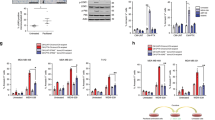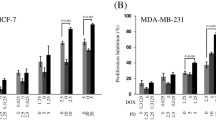Abstract
The use of breast tumor differentiating agents to complement existing therapies has the potential to improve breast cancer treatment. Previously we showed quinidine caused MCF-7 cells to synchronously arrest in G1 phase of the cell cycle, transition into G0 and undergo progressive differentiation. After 72–96 h cells became visibly apoptotic. Using several analogs of quinidine we determined that MCF-7 cell cycle exit and differentiation are typical of quinoline antimalarial drugs bearing a tertiary amine side chain (chloroquine, quinine, quinidine). Differentiated cells accumulated lipid droplets and mammary fat globule membrane protein. Apoptosis was assayed by a nucleosome release ELISA. Quinidine and chloroquine triggered apoptosis, but not quinine, a quinidine stereoisomer that displayed weak DNA binding. The apoptotic response to quinidine and chloroquine was p53-dependent. A 4–15-fold induction of p21(WAF1) protein was observed in cells treated with quinidine or chloroquine prior to apoptosis, but p21(WAF1) was not increased in cells that differentiated in response to quinine. Chloroquine was most active in stimulating MCF-7 apoptosis, and quinine was most active in promoting MCF-7 cell differentiation. We conclude, distinct mechanisms are responsible for breast tumor cell differentiation and activation of apoptosis by quinoline antimalarials. Alkylamino-substituted quinoline ring compounds represented by quinidine, quinine, and chloroquine will be useful model compounds in the search for more active breast tumor differentiating agents.
Similar content being viewed by others
References
Webster Jr LT: Drugs used in the chemotherapy of protozoal infections: malaria. In: Goodman AG, Goodman LS, Rall TW, Murad F (eds) The Pharmacological Basis of Therapeut-ics. 7th edn MacMillan Publishing Company, NY, 1985, pp 1029–1048
Woodfork KA, Wonderlin WF, Peterson VA, Strobl JS: Inhib-ition of ATP-sensitive potassium channels causes reversible cell-cycle arrest of human breast cancer cells in tissue culture. J Cell Physiol 162: 163–171, 1995
Wang S, Melkoumian ZK, Woodfork KA, Cather C, Davidson AG, Wonderlin WF, Strobl JS: Evidence for an early G1 ionic event necessary for cell cycle progression and survival in the MCF-7 human breast carcinoma cell line. J Cell Physiol 176: 456–464, 1998
Zhou Q, Melkoumian ZK, Lucktong A, Moniwa M, Davie JR, Strobl JS: Rapid induction of histone hyperacetylation and cellular differentiation in human breast tumor cell lines fol-lowing degradation of histone deacetylase-1.J Biol Chem 275: 35256–35263, 2000
Melkoumian ZK, Martirosyan AR, Strobl JS: Myc protein is differentially sensitive to quinidine in tumor versus immortalized breast epithelial cells. Int J Cancer (in revision)
Munster PN, Troso-Sandoval T, Rosen N, Rifkind R, Marks PA, Richon VM: The histone deacetylase inhibitor suberoylanilide hydroxamic acid induces differentiation of human breast cancer cells. Cancer Res 61: 8492–8497, 2001
Graham KA, Buick RN: Sodium butyrate induces differen-tiation in breast cancer cell lines expressing the estrogen receptor. J Cell Physiol 136(1): 63–71, 1988
Udenfriend S: Drugs and toxic agents. In: Fluorescence Assay in Biology and Medicine. Vol 1, Academic Press, NY, 1962, pp 400–443
Hahn FE: Chloroquine. In: Corcoran JW, Hahn FE, (eds) Antibiotics, Vol III, Mechanism of Action of Antimicrobial and Antitumor Agents. Springer-Verlag Press, NY, 1975, pp 58–78
Van Dierendonck JH, Keijzer R, Van De Velde CJ, Cornelisse CJ: Nuclear distribution of the Ki-67 antigen during the cell cycle: comparison with growth fraction in hu-man breast cancer cells. Cancer Res 49(11): 2999–3006, 1989.
Bancroft JD, Cook HC: Manual of Histological Techniques. Churchill Livingstone, Edinburgh 1984, pp 132–133
Munster PN, Srethapakdi M, Moasser MM, Rosen N: Inhibition of heat shock protein 90 function by ansamycins causes the morphological and functional differentiation of breast cancer cells. Cancer Res 61(7): 2945–2952, 2001
Turnbull JE, Baildam AD, Barnes DM, Howell A: Molecular expression of epitopes recognized by monoclonal antibodies HMFG and HMFG-2 in human breast cancers: diversity, variability and relationship to prognostic factors. Int J Cancer 38(1): 89–96, 1986
Giocanti N, Hennequin C, Balosso J, Mahler M, Favaudon V: DNA repair and cell cycle interactions in radiation sensitization by the topoisomerase II poison etoposide. Cancer Res 53(9): 2105–2111, 1993
Yoshida M, Horinouchi S: Trichostatin and leptomycin. Inhibtion of histone deacetylation and signal-dependent nuclear export. Ann NY Acad Sci 886: 23–36, 1999
Kim YB, Ki SW, Yoshida M, Horinouchi S: Mechanism of cell cycle arrest caused by histone deacetylase inhibitors in human carcinoma cells. J Antibiot (Tokyo) 53(10): 1191–1200, 2000
Davidson MW, Griggs BG, Boykin DW, Wilson WD: Molecular structural effects involved in the interaction of quinoline methanolamines with DNA. Implications for antimalarial action. J Med Chem 20: 1117–1122, 1977
Esposito F, Sinden RR: Supercoiling in prokaryotic and eukaryotic DNA: changes in response to topological perturbation of plasmids in E.coli and SV40 in vitro, in nuclei and in CV-1 cells. Nucl Acids Res 15: 5105–5124, 1987
Vogelstein B, Kinzler KW: Has the breast cancer gene been found? Cell 79(1): 1–3, 1994
El-Deiry WS, Tokino T, Waldman T, Oliner JD, Velculescu VE, Burrell M, Hill DE, Healy E, Rees JL, Hamilton SR: Topological control of p21WAF1/CIP1 expression in normal and neoplastic tissues. Cancer Res 55(13): 2910–2919, 1995
O'Brien RL, Allision JL, Hahn FE: Evidence for intercalation of chloroquine into DNA. Biochim Biophys Acta 129(3): 622–624, 1966
Michael RO, Williams GM: Chloroquine inhibition of repair of DNA damage induced in mammalian cells by methyl methanesulfonate. Mutat Res 25(3): 391–396, 1974
Sorensen M, Sehested M, Jensen PB: pH-dependent regulation of camptothecin-induced cytotoxicity and cleavable complex formation by the antimalarial agent chloroquine. Biochem Pharmacol 54(3): 373–380, 1997
Snyder RD: Use of catalytic topoisomerase II inhibitors to probe mechanisms of chemical-induced clastogenicity in Chinese hamster V79 cells. Environ Mol Mutagen 35(1): 13–21, 2000
Chen AY, Liu LF: DNA topoisomerases: essential enzymes and lethal targets. Annu Rev Pharmacol Toxicol 34: 191–218, 1994
Solary E, Bertrand R, Pommier Y: Apoptosis induced by DNA topoisomerase I and II inhibitors in human leukemic HL-60 cells. Leuk Lymphoma 15(1–2): 21–32, 1994
Sheikh MS, Rochefort H, Garcia M: Overexpression of p21WAF1/CIP1 induces growth arrest, giant cell formation and apoptosis in human breast carcinoma cell lines. Oncogene 11(9): 1899–1905, 1995
Yoshida M, Furumai R, Nishiyama M, Komatsu Y, Nishino N, Horinouchi S: Histone deacetylase as a new target for cancer chemotherapy. Cancer Chemother Pharmacol (suppl 1): S20–26, 2001
Marks PA, Richon VM, Rifkind RA. Histone deacetylase inhibitors: inducers of differentiation or apoptosis of trans-formed cells. J Natl Cancer Inst 92(15): 1210–1216, 2000
Author information
Authors and Affiliations
Rights and permissions
About this article
Cite this article
Zhou, Q., McCracken, M.A. & Strobl, J.S. Control of Mammary Tumor Cell Growth in Vitro by Novel Cell Differentiation and Apoptosis Agents. Breast Cancer Res Treat 75, 107–117 (2002). https://doi.org/10.1023/A:1019698807564
Issue Date:
DOI: https://doi.org/10.1023/A:1019698807564




